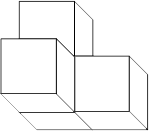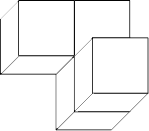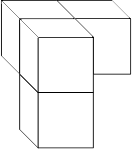View from a different angle
0
Overview
Using this Resource
Connecting to the Curriculum
Marking Student Responses
Working with Students
Further Resources
This task is about recognising a 3-D shape from different angles.
Task administration:
This task can be completed with pencil and paper or online (with auto-marking displayed to students).
Copyright:
Graphics copyright (c) NZCER
Level:
4
Curriculum info:
Keywords:
Description of task:
Students identify shapes after they have been rotated in 3 dimensions.
Curriculum Links:
This resource can help to identify students' ability to sort 3-dimensional shapes into classes.
Learning Progression Frameworks
This resource can provide evidence of learning associated with within the Mathematics Learning Progressions Frameworks.
Read more about the Learning Progressions Frameworks.Answers/responses:
| Y8 (10/2015) | |
|
Each individual shape correctly identified as identical or different
All 9 shapes correct (i.e., 3 correct identical options identified)
8 or more shapes correct, with none incorrect  |
very easy
easy
very easy
|
Based on a representative sample of 102 Y8 students.
Teaching and learning:
- This resource is about being able to visualise in three dimensions by recognising which objects are identical to a given one.
- Students need to be able to visualise the effects of rotating the given 3-D shape.
- Students in the trial found each individual shape very easy, but only about two-thirds of them could get all nine shapes correct.
Diagnostic and formative information:
| Common error | |
|
 |
|
 |
|
 or or  |
Next steps:
Visualising more complex rotation
These students may need more practice drawing 2-D representations of 3-D shapes (Click on views for examples). They may then need practice on visualising 2-D representations of 3-D shapes.
Visualising more complex shapes
Students could use explore the different shapes in the soma cube, especially the three that have a height and a width of two cubes. Two of these are mirror images, and the third is the initial shape given in this resource. Students may also need more practice on visualising 2-D representations of 3-D shapes. Students could use digital technology and take their own photos of 3-D shapes, and make this type of problem to give their peers to solve.
The resource View from a different angle II is very similar, but focusses on reflection as well as rotation. This makes it a harder option for students.
- Different views
- Cutting food
- Crawling ant problem
- Cubes and faces III
- Isometric drawing
- Different views II
- Drawing prisms
- Drawing 3-d Shapes II
- Isometric views
- Isometric block tower
- Drawing isometric shapes
- Drawing isometric block towers
- Constructing Ziggurats
- Isometric sketches
- View from a different angle II
- Matching nets
- Matching nets II

